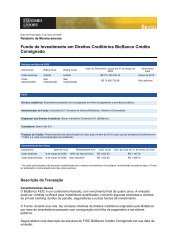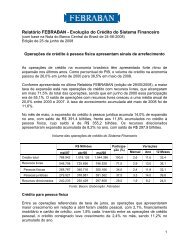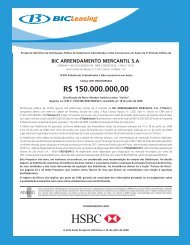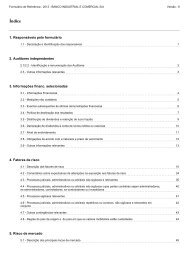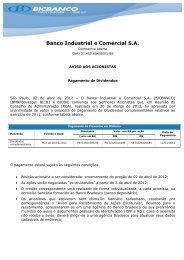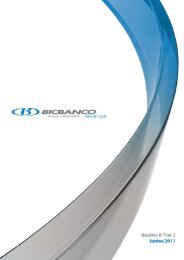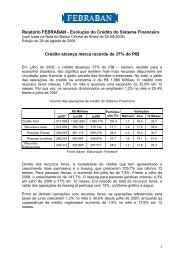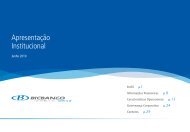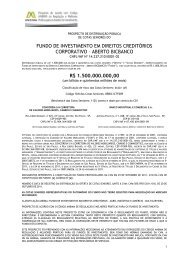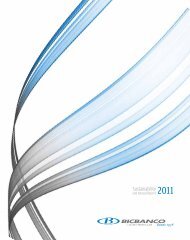HSBC J.P. Morgan Standard Chartered Bank - bicbanco
HSBC J.P. Morgan Standard Chartered Bank - bicbanco
HSBC J.P. Morgan Standard Chartered Bank - bicbanco
You also want an ePaper? Increase the reach of your titles
YUMPU automatically turns print PDFs into web optimized ePapers that Google loves.
FOREIGN EXCHANGE RATES AND EXCHANGE CONTROLS<br />
Until March 14, 2005, there were two legal foreign exchange markets in Brazil, the commercial rate<br />
exchange market and the floating rate exchange market. The commercial rate exchange market was reserved<br />
primarily for foreign trade transactions and transactions that generally required prior approval from Brazilian<br />
monetary authorities, such as the purchase and sale of registered investments by foreign persons and related<br />
remittances of funds abroad (including the payment of principal of and interest on loans, notes, bonds and other debt<br />
instruments denominated in foreign currencies and duly registered with the Central <strong>Bank</strong>). Purchases of foreign<br />
exchange in the commercial market could be carried out only through a financial institution in Brazil authorized to<br />
buy and sell currency in that market. The commercial market rate was the commercial selling rate for converting<br />
Brazilian currency into U.S. dollars, as reported by the Central <strong>Bank</strong>. The floating market rate generally applied to<br />
specific transactions for which Central <strong>Bank</strong> approval was not required.<br />
In March 2005, the CMN enacted new rules with respect to the foreign exchange market in Brazil. The<br />
new regulations unified the two previously existing foreign exchange markets into a single foreign exchange market,<br />
or the Foreign Exchange Market. The new regulations also eliminated previous restrictions and allowed more<br />
flexibility for the purchase and sale of foreign currency. The Foreign Exchange Market is intended to simplify both<br />
inbound and outbound foreign exchange transactions by permitting exchange contracts to be executed by those local<br />
institutions that are authorized to deal in foreign exchange.<br />
Brazilian foreign exchange rules have been made more flexible recently. For example, current regulations<br />
provide that all proceeds from the export of goods or services be kept in bank accounts outside of Brazil and<br />
eventually used abroad, without any need to repatriate such amounts.<br />
Based on Resolution No. 3,719/09, local exporters are allowed to keep up to 100% of their export proceeds<br />
abroad and freely dispose of such amounts (including transferring them to foreign third parties), with due regard for<br />
the rules issued by the CMN and by the Federal Revenue Office in Brazil. Such proceeds held abroad, however,<br />
cannot be lent by Brazilian exporters.<br />
The Central <strong>Bank</strong> may, however, in limited circumstances intervene in the foreign exchange market to curb<br />
excessive volatility. The foreign exchange rate is reported by the Central <strong>Bank</strong> on a daily basis.<br />
The following tables set forth the selling rates of the Foreign Exchange Market selling rates published by<br />
the Central <strong>Bank</strong> at the close of business day, expressed in reais per U.S. dollar for the periods and dates indicated.<br />
Closing Selling Rates of Reais per U.S.$1.00<br />
Year Ended December 31, Low High Average (1) Period End<br />
2007 ............................................................................................... 1.73 2.16 1.95 1.77<br />
2008 ............................................................................................... 1.56 2.50 1.84 2.34<br />
2009 ............................................................................................... 1.70 2.42 1.99 1.74<br />
Closing Selling Rates of Reais per U.S.$1.00<br />
Month Low High Average (1) Period End<br />
January 2010 ................................................................................. 1.72 1.87 1.78 1.87<br />
February 2010 ............................................................................... 1.80 1.88 1.84 1.81<br />
March 2010.................................................................................... 1.76 1.82 1.79 1.78<br />
April 2010 (through April 19, 2010) (2) ......................................... 1.73 1.79 1.76 1.75<br />
______________________<br />
Note:<br />
(1) Represents the average of the rates on each business day in the period.<br />
(2) On April 19, 2010, the exchange rate published by the Central <strong>Bank</strong> was R$1.75 per U.S.$1.00.<br />
Brazilian law provides that in the event of a serious imbalance in Brazil’s balance of payments, or a<br />
foreseeable likelihood of such an imbalance, temporary restrictions may be imposed on remittances of foreign<br />
capital abroad. There can be no assurance that such measures will not be taken by the Brazilian government in the<br />
future. See “Risk Factors—Risks Relating to the <strong>Bank</strong> and the Brazilian <strong>Bank</strong>ing Industry.”<br />
AMR-248898-v2<br />
- 32 -<br />
95-40469277



